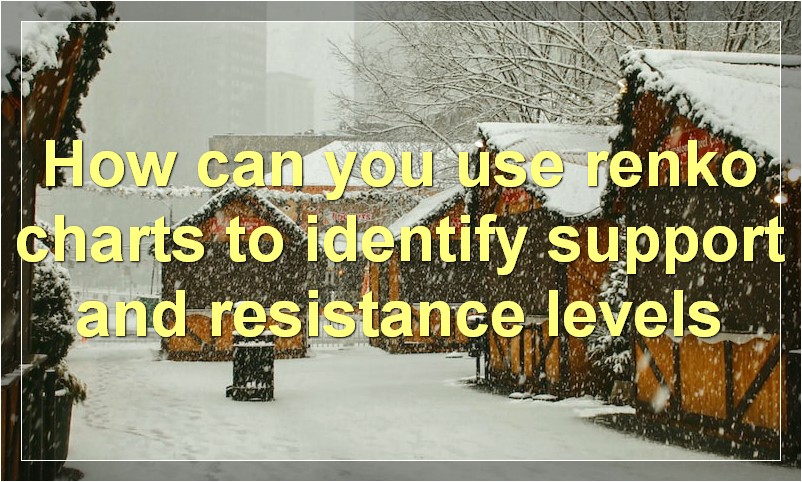Renko charts are a type of chart that is gaining popularity among traders. However, there are benefits and limitations to using Renko charts that must be considered before using them.
What is the difference between a renko bar and a candlestick

There are a few key differences between renko bars and candlesticks that make them better suited for different types of traders.
Renko bars are based on price movement, rather than time like candlesticks are. This makes them ideal for those who want to trade trends, as you can more easily see when the price is moving in a certain direction.
Candlesticks, on the other hand, give you more information about the market as a whole. Each candle represents a specific period of time, so you can get an idea of how the market is behaving over a certain period. This is useful for those who want to trade based on news or events, as you can see how the market reacts to them.
How do you construct a renko chart
There are a few different ways to construct a renko chart, but the most common method is to use candlestick data. To do this, you first need to calculate the price range for each brick. The price range is simply the difference between the open and close prices of each candlestick. Once you have the price range for each candlestick, you can then plot them on a graph with the close price of each candlestick serving as the starting point for the next brick.
The other main way to construct a renko chart is by using tick data. To do this, you need to first identify the minimum price movement that you want your bricks to represent. This is typically done by looking at the average true range (ATR) of the security over a certain period of time. Once you have identified the minimum price movement, you can then start plotting your bricks. Each brick will represent a certain number of ticks (i.e. price movements). For example, if you wanted each brick to represent 5 ticks and the security you were watching had an ATR of 10, then each brick would be worth 50 points.
What is the significance of the open/close price in a renko bar
The open/close price in a renko bar is significant because it represents the price at which the bar was opened and closed. This information can be used to help traders make informed decisions about when to enter and exit trades.
Why are renko charts useful for technical analysis
Renko charts are a type of technical analysis chart that is used to predict future price movements. The name “Renko” comes from the Japanese word for bricks, which is what the chart looks like when it is created.
The key feature of Renko charts is that they only show price movement if it is above or below a certain threshold. This makes it easier to identify trends and support and resistance levels. Renko charts can be used on any time frame, but they are most commonly used on longer time frames such as daily or weekly charts.
There are a few different ways to construct Renko charts, but the most common method is to use a fixed box size. This means that each brick on the chart represents a certain price move. For example, if the box size is set at $1, then each brick will represent $1 of price movement.
Renko charts are considered to be leading indicators, which means that they can help predict future price movements. However, like all technical indicators, they are not perfect and should be used in conjunction with other indicators and market analysis techniques.
How can you use renko charts to identify support and resistance levels

Renko charts are a type of chart that is created by placing a brick in the next column once the price surpasses the top or bottom of the previous brick by a predefined amount. This amount is typically based on percentage move or ATR. These charts don’t have time built into them and only focus on price changes. This can be helpful when trying to identify support and resistance levels because you’re not seeing all of the noise that can come with time-based charts.
To find support and resistance with Renko charts, you’ll want to look for areas where the bricks start to stack up. This will show you areas where the price has found some support or resistance and is starting to move in a certain direction. You can then use these levels to help make trading decisions.
If you see a area where the bricks are starting to stack up and the price is beginning to move higher, you may want to consider taking a long position. Alternatively, if you see a area where the bricks are starting to stack up and the price is beginning to move lower, you may want to consider taking a short position.
Of course, you’ll want to use other indicators and tools in conjunction with Renko charts to make sure that your trade has a good chance of success. But using Renko charts can help you get a better idea of where support and resistance levels may be so that you can make more informed trading decisions.
What other indicators can be used in conjunction with renko charts
There are a few other indicators that can be used in conjunction with renko charts to help make informed trading decisions. Some of these include the moving average convergence divergence (MACD) indicator, the relative strength index (RSI), and the stochastic oscillator. Each of these indicators can provide valuable information about the direction and momentum of a security, and when used together, can give a more complete picture of the market.
What are the limitations of renko charts
Renko charts are a type of chart used in technical analysis that uses bricks of a fixed size to indicate price movements. The size of the brick is typically based on a percentage or dollar amount move in price. Renko charts can be useful for identifying support and resistance levels, trend direction, and potential reversals. However, there are some limitations to using Renko charts that traders should be aware of.
One limitation of Renko charts is that they can be slow to respond to price changes. This is because each brick is based on a fixed move in price, so if prices are moving up or down slowly, the Renko chart will not show these changes until the price has moved by the required amount. This can make it difficult to trade using Renko charts in a volatile market where prices are changing quickly.
Another limitation of Renko charts is that they can give false signals. This is because the bricks are based on a fixed move in price, so if there is a sudden spike or drop in price, this will be reflected as a single brick on the chart even though it may not be indicative of a real change in trend. False signals can also occur if there is a lot of noise in the market and prices are fluctuating randomly.
Overall, Renko charts can be a useful tool for technical analysis but traders should be aware of their limitations before using them.
How often do renko bars form
This is a difficult question to answer, as it depends on a number of factors, including the market conditions and the trading strategy being used. Generally speaking, however, renko bars tend to form relatively frequently in markets that are trending, and less frequently in markets that are range-bound or choppy.
What is the average length of a renko bar
A Renko chart is a type of chart, developed by the Japanese, that is built using price movement rather than both price and time. The word “Renko” comes from the Japanese word for “brick”. In a Renko chart, a brick is placed at a 45-degree angle when the price moves up by a pre-determined amount. A brick is placed at a 135-degree angle when the price moves down by that same amount.
The average length of a renko bar can be calculated by taking the difference in price between the open and close of the bar and dividing it by the number of bricks in the bar.

